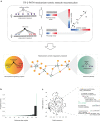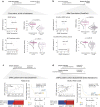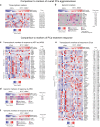Mechanism-centric regulatory network identifies NME2 and MYC programs as markers of Enzalutamide resistance in CRPC
- PMID: 38191557
- PMCID: PMC10774320
- DOI: 10.1038/s41467-024-44686-5
Mechanism-centric regulatory network identifies NME2 and MYC programs as markers of Enzalutamide resistance in CRPC
Abstract
Heterogeneous response to Enzalutamide, a second-generation androgen receptor signaling inhibitor, is a central problem in castration-resistant prostate cancer (CRPC) management. Genome-wide systems investigation of mechanisms that govern Enzalutamide resistance promise to elucidate markers of heterogeneous treatment response and salvage therapies for CRPC patients. Focusing on the de novo role of MYC as a marker of Enzalutamide resistance, here we reconstruct a CRPC-specific mechanism-centric regulatory network, connecting molecular pathways with their upstream transcriptional regulatory programs. Mining this network with signatures of Enzalutamide response identifies NME2 as an upstream regulatory partner of MYC in CRPC and demonstrates that NME2-MYC increased activities can predict patients at risk of resistance to Enzalutamide, independent of co-variates. Furthermore, our experimental investigations demonstrate that targeting MYC and its partner NME2 is beneficial in Enzalutamide-resistant conditions and could provide an effective strategy for patients at risk of Enzalutamide resistance and/or for patients who failed Enzalutamide treatment.
© 2024. The Author(s).
Conflict of interest statement
S.A.A. is a coinventor on patents covering the methods and assays to identify and characterize MYC inhibitors and derivatives (US11420957B2, “Substituted heterocycles as c-MYC targeting agents”). A.M., S.P., S.A.A. E.M.S., and V.K. are coinventors on patent applications covering the methods and assays to identify Enzalutamide-responsive tumors (PCT Application No. PCT/US2023/065533, “MYC program as a marker of response to Enzalutamide in prostate cancer”). A.M. and S.P. are coinventors on patent applications covering the computational method TR-2-PATH (U.S. Patent Application No. 18/297,470, “Identifying treatment response signatures”). The remaining authors declare no competing interests.
Figures







References
-
- Huggins C, Hodges CV. Studies on prostatic cancer. I. The effect of castration, of estrogen and of androgen injection on serum phosphatases in metastatic carcinoma of the prostate. Cancer Res. 1941;1:293–297. - PubMed
Publication types
MeSH terms
Substances
Grants and funding
LinkOut - more resources
Full Text Sources
Research Materials
Miscellaneous

